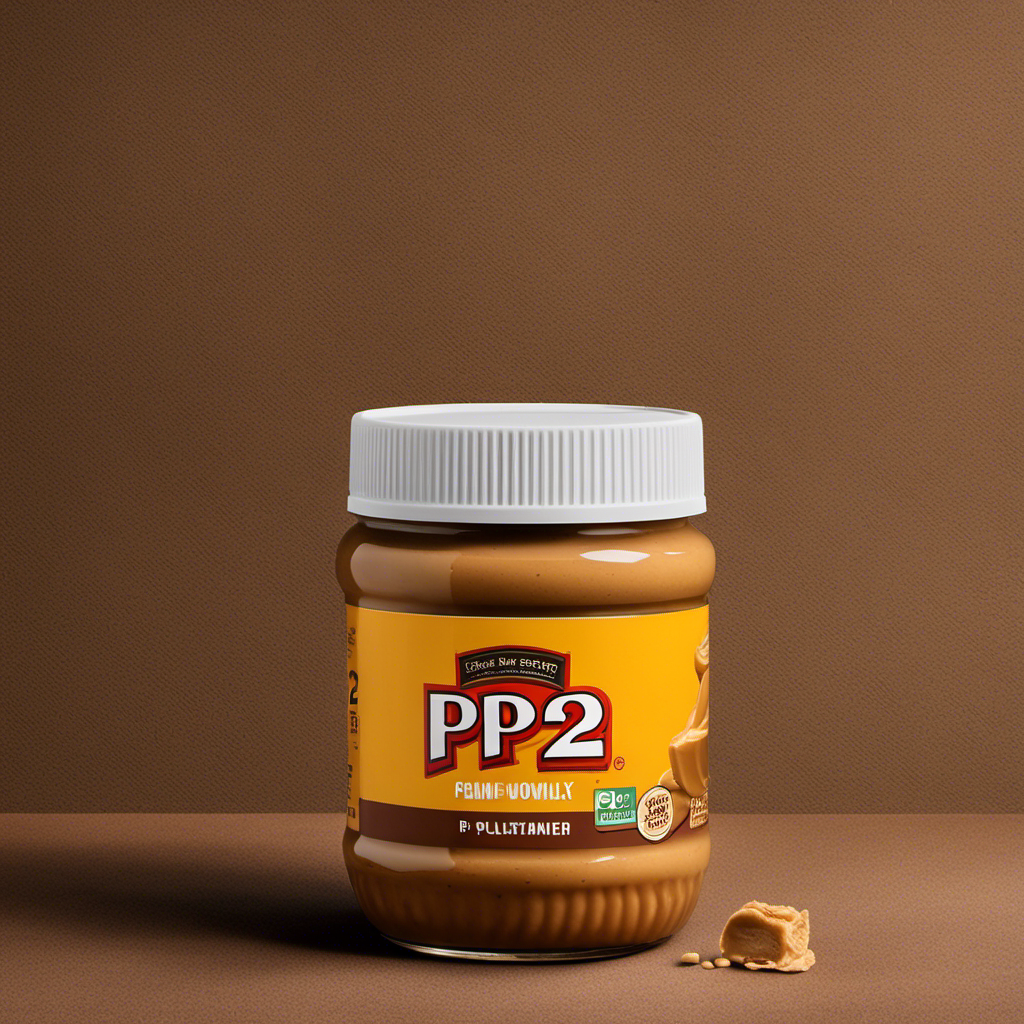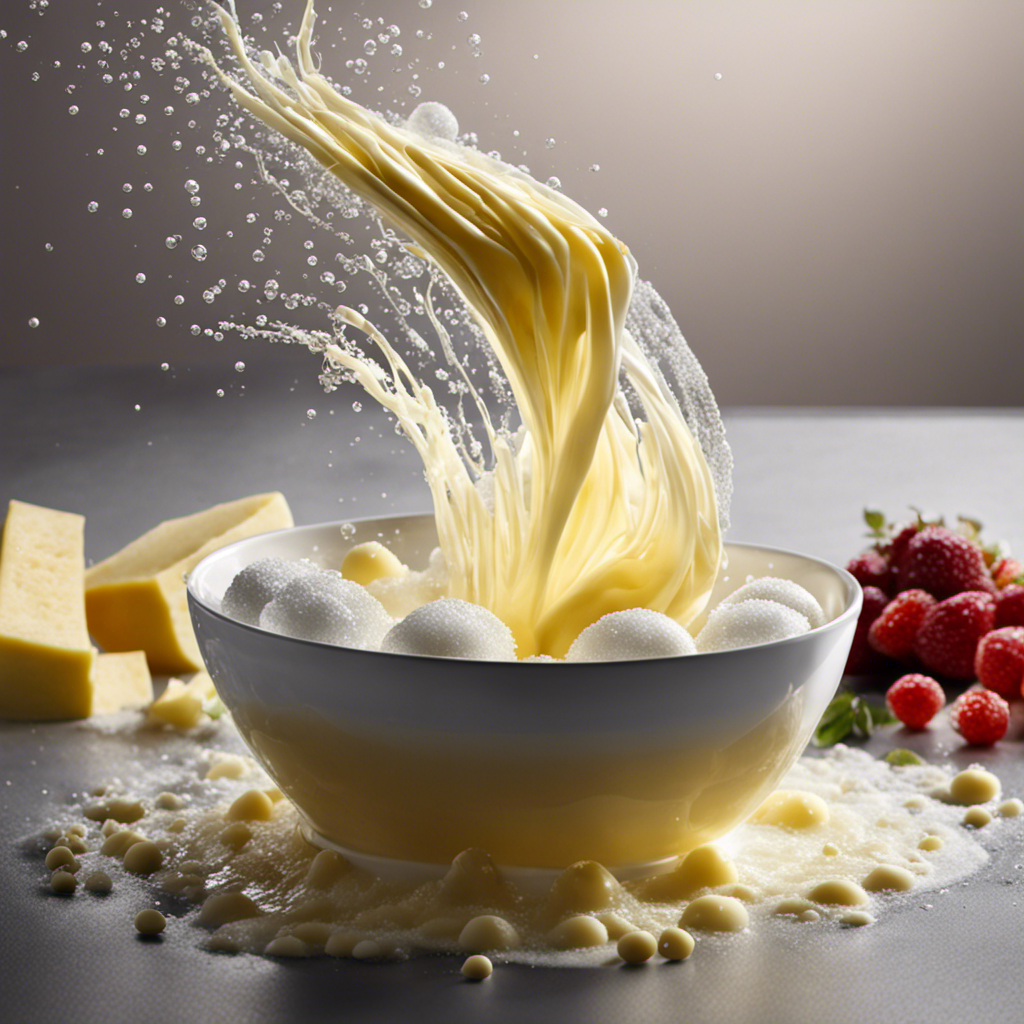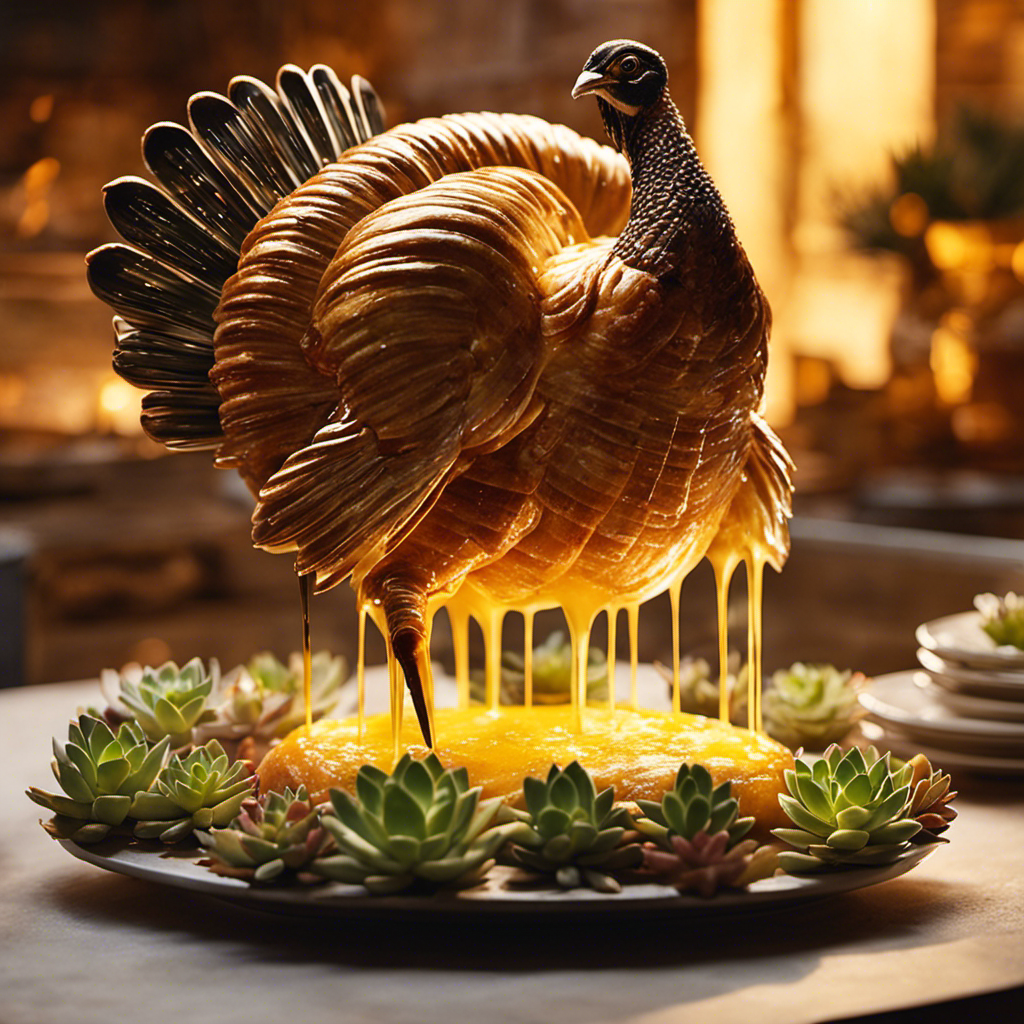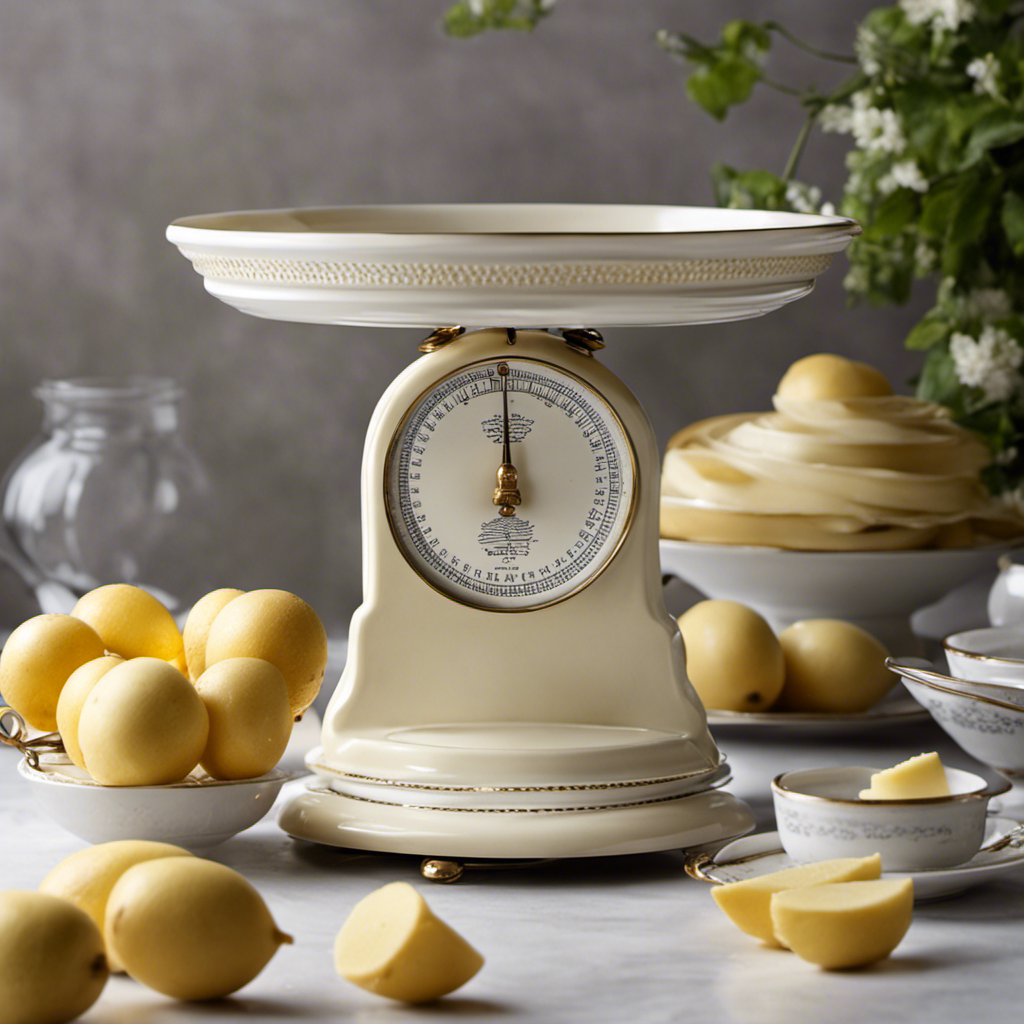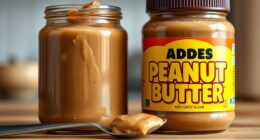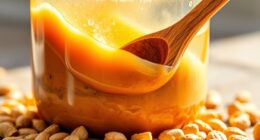Hello there!
So, have you ever wondered who’s behind the deliciousness of PB2 Peanut Butter? Well, let me tell you, my friend, it’s quite an interesting story.
The maker of PB2 Peanut Butter is none other than Bell Plantation. They’ve been whipping up this tasty spread since way back when. And let me tell you, they know their stuff.
From the origins to the ingredients, I’m here to give you all the juicy details. So sit back, relax, and get ready to dive into the world of PB2 Peanut Butter.
Key Takeaways
- PB2 peanut butter was created by Bell Plantation with a unique production process that involves pressing roasted peanuts to remove most of their natural oils, resulting in a powdered form.
- The founder of PB2 was inspired to create a healthier alternative to traditional peanut butter and faced challenges in developing the perfect formula and educating consumers about the benefits of powdered peanut butter.
- PB2 offers a lower-fat alternative to traditional peanut butter while still providing a good source of protein and essential nutrients.
- PB2 is made from roasted peanuts, with oil and fat removed, and is stabilized with a small amount of sugar and salt for freshness. It is praised for its convenience, versatility, and nutritious qualities.
History of Pb2 Peanut Butter
You’ll be interested to know that the history of PB2 peanut butter dates back to the early 2000s. The inspiration behind PB2 came from the founder’s desire to create a healthier alternative to traditional peanut butter. The founder, a food scientist, recognized the high fat content of regular peanut butter and wanted to develop a product that could offer the same great taste but with fewer calories and less fat.
To achieve this, the founder developed a unique production process for PB2 peanut butter. The process starts with high-quality roasted peanuts that are carefully selected for their flavor and texture. These peanuts are then pressed to remove most of their natural oils, resulting in a powder-like substance. The powder is then combined with a small amount of sugar and salt to enhance the taste.
The final product is a delicious and nutritious peanut butter powder that can be reconstituted with water or used as a dry ingredient in various recipes. This innovative production process allows PB2 to have 90% less fat and almost 70% fewer calories than traditional peanut butter, making it a popular choice among health-conscious individuals.
Overall, the history of PB2 peanut butter is rooted in the founder’s inspiration to create a healthier alternative without compromising on taste. The unique production process employed ensures that PB2 retains all the flavor and goodness of traditional peanut butter while offering a lighter and more nutritious option.
Founder of Pb2 Peanut Butter
While it’s widely known that the founder of Pb2 is not a household name, their story is quite fascinating. The founder’s inspiration for creating Pb2 peanut butter came from a desire to provide a healthier alternative to traditional peanut butter. They noticed that many people were looking for ways to reduce fat and calories in their diets without sacrificing taste. This led them to experiment with different methods of extracting oil from peanuts, ultimately resulting in the creation of Pb2.
Early on, the founder faced several challenges in bringing Pb2 to market. Here are four key hurdles they had to overcome:
-
Developing the perfect formula: The founder spent countless hours in their kitchen, experimenting with various peanut powder ratios and refining the process to ensure the best taste and texture.
-
Educating consumers: Pb2 was a completely new concept, so the founder had to educate consumers about the benefits of powdered peanut butter and how to use it in their everyday lives.
-
Building brand awareness: With limited resources, the founder had to work hard to spread the word about Pb2 and convince retailers to carry their product.
-
Scaling up production: As demand for Pb2 grew, the founder had to figure out how to scale up production without compromising the quality of the product.
Despite these early challenges, the founder’s dedication and perseverance paid off, leading to the widespread popularity of Pb2 peanut butter.
Transitioning to the subsequent section, let’s explore the origins of Pb2 and how it became a household name.
Origins of Pb2 Peanut Butter
When it comes to Pb2 peanut butter, it’s important to understand its creation, the ingredients used, and the health benefits it offers.
Pb2 is a powdered peanut butter that was developed to provide a lower-fat alternative to traditional peanut butter. It is made by pressing roasted peanuts to remove most of the oil and then grinding them into a fine powder.
The resulting product is not only delicious but also offers health benefits such as being lower in calories and fat compared to regular peanut butter, while still providing a good source of protein and essential nutrients.
Creation of Pb2
The maker of PB2 peanut butter is Bell Plantation. They have perfected the manufacturing process of PB2 to create a high-quality product that has gained positive customer reviews. Here are four key aspects of the PB2 manufacturing process:
-
Roasting: Bell Plantation carefully roasts the peanuts to enhance their flavor and create a rich, nutty taste in the final product.
-
Pressing: After roasting, the peanuts are pressed to extract their natural oils. This process helps to reduce the fat content in PB2 while retaining the peanut flavor.
-
Grinding: The pressed peanuts are then ground into a fine powder. This powder is what gives PB2 its smooth and creamy texture when mixed with water.
-
Stabilizing: To ensure the longevity of PB2, Bell Plantation adds a small amount of sugar and salt to stabilize the product. This helps to maintain its freshness and taste over time.
Customers rave about the convenience and versatility of PB2, praising its ability to deliver the taste of traditional peanut butter with fewer calories and fat.
Ingredients Used in Pb2
You’ll be happy to know that the ingredients used in PB2 are carefully chosen to ensure a high-quality and flavorful product. PB2 is made from roasted peanuts that are pressed to remove most of the oil and fat, resulting in a powdered form of peanut butter. This process reduces the calorie and fat content by 85% compared to traditional peanut butter. The table below showcases the ingredients used in PB2 and their benefits:
| Ingredient | Health Benefits |
|---|---|
| Roasted Peanuts | Excellent source of protein, rich in healthy fats and fiber |
| Sugar | Provides sweetness without adding a significant amount of calories |
| Salt | Enhances flavor and helps balance the taste |
| Natural Flavor | Adds a delicious and authentic peanut taste |
| Antioxidant | Helps protect the peanut butter from spoiling and provides health benefits |
Health Benefits of Pb2?
By carefully selecting its ingredients, PB2 offers a nutritious and flavorful alternative for those seeking health benefits. This low-fat alternative is made with natural ingredients that provide various health benefits. Here are four reasons why PB2 is a great choice for health-conscious individuals:
-
Reduced Fat: PB2 contains only a fraction of the fat found in traditional peanut butter, making it a healthier option for those watching their fat intake.
-
Protein Boost: PB2 is rich in protein, which is essential for muscle repair and growth. Adding PB2 to your diet can help you meet your daily protein needs.
-
Added Vitamins and Minerals: PB2 is fortified with vitamins and minerals like vitamin E and magnesium, which contribute to overall health and well-being.
-
Versatility: PB2 can be used in a variety of recipes, from smoothies and oatmeal to sauces and baked goods, making it a versatile and nutritious addition to your diet.
Incorporating PB2 into your diet can be a delicious way to enjoy the health benefits of peanut butter while reducing your fat intake.
The Making of Pb2 Peanut Butter
When it comes to understanding the making of Pb2 Peanut Butter, it’s important to delve into two key aspects: the ingredients and the process.
The ingredients used in Pb2 Peanut Butter include roasted peanuts, sugar, and salt, which are then processed to create a powdered form. The process involves pressing the peanuts to remove the oil, and then grinding them into a fine powder.
Exploring the nutritional benefits of Pb2 Peanut Butter reveals that it is low in fat and calories compared to traditional peanut butter, making it a popular choice for those looking to reduce their fat intake while still enjoying the taste of peanut butter.
Ingredients and Process
The maker of PB2 peanut butter uses a unique process to create a powdered peanut butter with fewer calories. This process involves removing the oil from roasted peanuts and then grinding them into a fine powder.
Here are four key points about the ingredients and process of PB2 peanut butter:
-
Low Fat: By removing the oil from peanuts, PB2 reduces the fat content significantly. It contains only 1.5 grams of fat per serving, making it a healthier alternative to regular peanut butter.
-
Versatile: PB2 can be used in a variety of ways. It can be mixed with water to create a spreadable peanut butter or added to smoothies, oatmeal, and baked goods for a nutty flavor.
-
Nutritional Benefits: PB2 is a good source of protein, fiber, and essential vitamins and minerals. It also contains no artificial additives or preservatives.
-
Recipe Friendly: PB2 peanut butter can be used in various recipes, such as Thai peanut sauce, peanut butter cookies, and peanut butter protein bars. It adds a delicious peanut flavor without the added calories and fat.
Overall, PB2 peanut butter is a versatile and healthier option for those looking to enjoy the taste of peanut butter without the guilt.
Nutritional Benefits Explained?
To understand the nutritional benefits of PB2, you’ll be pleased to know that it is a good source of protein, fiber, and essential vitamins and minerals.
PB2 is a low fat alternative to traditional peanut butter, making it a popular choice for those looking to reduce their fat intake. A nutritional analysis of PB2 reveals that it contains about 45 calories per serving, with 4 grams of protein and 2 grams of fiber. It also provides essential vitamins and minerals such as vitamin E, niacin, and magnesium. These nutrients are important for maintaining overall health and supporting various bodily functions.
Additionally, PB2 is a convenient option for those with dietary restrictions, as it is gluten-free and suitable for vegans.
Pb2 Peanut Butter Ingredients
Pb2 peanut butter contains powdered peanuts and sugar as its main ingredients. It is a popular alternative to traditional peanut butter for those looking for a lower calorie and lower fat option. Here are four things you should know about pb2 peanut butter:
-
Healthier alternative: Pb2 peanut butter is made by removing most of the oil from peanuts, resulting in a powder that can be reconstituted with water to create a spreadable consistency. This process significantly reduces the fat content of the peanut butter, making it a healthier option for those watching their calorie and fat intake.
-
Versatile ingredient: Pb2 peanut butter can be used in a variety of ways in recipes. It can be mixed with water to create a spread, added to smoothies for a nutty flavor, or used as an ingredient in baking. Its versatility makes it a great addition to any pantry.
-
Nutritional benefits: While pb2 peanut butter has less fat than traditional peanut butter, it still provides a good amount of protein and fiber. It is also a good source of vitamins and minerals, including vitamin E and magnesium.
-
Peanut butter alternatives: If you’re looking for other alternatives to traditional peanut butter, there are several options available. Almond butter, cashew butter, and sunflower seed butter are all popular choices that offer similar flavors and nutritional profiles.
Nutritional Value of Pb2 Peanut Butter
When it comes to finding a low calorie alternative to regular peanut butter, Pb2 peanut butter is an excellent choice. Not only does it have significantly fewer calories, but it also offers a comparable protein content when compared to traditional peanut butter.
In addition to being a low calorie option and a good source of protein, Pb2 peanut butter also offers a range of health benefits. It is a good source of healthy fats and contains no added sugars or preservatives.
Overall, Pb2 peanut butter is a great choice for those looking to reduce their calorie intake while still enjoying the taste and benefits of peanut butter.
Low Calorie Alternative
You can find a low calorie alternative to regular peanut butter by trying PB2. It is a powdered peanut butter that has significantly fewer calories and fat than traditional peanut butter. Here is a nutritional comparison between 2 tablespoons of PB2 and regular peanut butter:
- PB2 has only 50 calories, while regular peanut butter has around 190 calories.
- PB2 contains only 1.5 grams of fat, whereas regular peanut butter has about 16 grams of fat.
- PB2 has 5 grams of protein, while regular peanut butter has 7-8 grams of protein.
- PB2 is lower in carbohydrates, with around 6 grams, compared to regular peanut butter which has 7-8 grams.
Not only is PB2 a healthier option, but it is also versatile in cooking. You can use it in smoothies, baked goods, sauces, and dressings, without sacrificing taste.
With PB2, you can enjoy the delicious flavor of peanut butter while keeping your calorie intake in check.
Protein Content Comparison
PB2’s protein content is lower compared to regular peanut butter. While regular peanut butter is made from 100% peanuts, PB2 is a powdered peanut butter that has undergone a process to remove most of the oil, resulting in a lower fat content. This process also reduces the protein content.
Regular peanut butter is a good source of protein, with approximately 8 grams of protein per 2 tablespoons. On the other hand, PB2 contains about 5 grams of protein per 2 tablespoons. If you are looking for a higher protein content, regular peanut butter may be a better choice. However, if you are trying to reduce your fat intake, PB2 can still be a good option.
Now, let’s move on to the health benefits overview.
Health Benefits Overview
The health benefits of PB2 include lower fat content and the potential to aid in weight loss due to its reduced calorie count. Here are four key benefits of PB2:
-
Low Calorie: PB2 has significantly fewer calories compared to traditional peanut butter. This makes it an excellent choice for those trying to reduce their calorie intake or lose weight.
-
Protein Content: Despite being lower in fat and calories, PB2 still contains a good amount of protein. Protein is essential for muscle recovery and growth, making PB2 a suitable option for athletes and fitness enthusiasts.
-
Versatility: PB2 can be used in a variety of ways, such as in smoothies, baked goods, or as a spread. Its versatility allows for a wide range of delicious and healthy creations.
-
Nutrient-rich: PB2 is packed with essential nutrients like vitamins, minerals, and antioxidants. These nutrients contribute to overall health and well-being.
Pb2 Peanut Butter Manufacturing Process
To make PB2 peanut butter, we start by roasting and grinding peanuts to create a smooth and creamy texture. This process ensures that the peanuts are evenly roasted, bringing out their natural flavors. After roasting, the peanuts are ground into a fine powder. This powder is then mixed with water to create a paste-like consistency. The paste is then pressed to remove any excess oil, resulting in a lower-fat peanut butter. Here is a table comparing the production methods of PB2 peanut butter and traditional peanut butter:
| PB2 Peanut Butter | Traditional Peanut Butter |
|---|---|
| Made from roasted and ground peanuts | Made from roasted peanuts |
| Pressed to remove excess oil | Usually contains higher fat content |
| Lower in calories and fat | Higher in calories and fat |
| Creamy texture | Creamy texture |
One of the key benefits of PB2 compared to traditional peanut butter is its lower fat and calorie content. By pressing the paste to remove excess oil, PB2 is able to provide a healthier alternative without compromising on taste or texture. Additionally, PB2 is a great option for those who are watching their calorie intake or following a low-fat diet. However, it’s important to note that PB2 may have a slightly different taste compared to traditional peanut butter due to the reduced fat content. Overall, PB2 peanut butter offers a convenient and healthier option for peanut butter lovers.
Pb2 Peanut Butter Distribution
When it comes to the distribution of Pb2 Peanut Butter, there are several key points to consider.
First, the brand has established global distribution channels, allowing it to reach customers all over the world.
Additionally, Pb2 Peanut Butter is readily available in local retail stores, making it easily accessible for those who prefer to shop in person.
Lastly, online purchasing options are also available, providing convenience and the ability to have Pb2 Peanut Butter delivered right to your doorstep.
Global Distribution Channels
Global distribution channels play a crucial role in getting PB2 peanut butter to consumers worldwide. Through effective global marketing strategies and efficient supply chain management, PB2 is able to reach customers in different countries and continents. Here are four key aspects of PB2’s global distribution channels:
-
International partnerships: PB2 collaborates with global distributors and retailers to ensure its products are available in various markets. This allows for wider reach and accessibility for consumers around the world.
-
Efficient logistics: PB2 prioritizes smooth transportation and timely delivery of its products. This involves careful coordination and optimization of shipping routes, customs procedures, and storage facilities to ensure the availability of PB2 peanut butter in different regions.
-
Localized marketing: PB2 understands the importance of tailoring its marketing strategies to specific regions and cultures. By adapting its messaging and promotional activities, PB2 is able to effectively connect with consumers in different parts of the world.
-
Online platforms: PB2 utilizes e-commerce platforms and online marketplaces to expand its global reach. This allows consumers to easily purchase PB2 products regardless of their location.
With a strong global distribution network in place, PB2 is able to make its peanut butter available to consumers worldwide, offering them a delicious and nutritious alternative.
Local Retail Availability
You can easily find PB2 peanut butter at local retailers near you, ensuring convenient access to this delicious and nutritious product.
PB2 peanut butter is widely available in various local retail options, thanks to its extensive distribution channels. Many grocery stores, health food stores, and even some convenience stores carry PB2 peanut butter on their shelves. It is also commonly found in specialty stores that focus on natural and organic products.
These local retail options make it easy for consumers to purchase PB2 peanut butter without having to travel far. However, if you prefer the convenience of shopping from home, PB2 peanut butter is also available for online purchasing.
Transitioning into the subsequent section about online purchasing options, let’s explore the various platforms where you can buy PB2 peanut butter online.
Online Purchasing Options
There’s a wide range of online platforms where you can easily purchase PB2 peanut butter. Whether you’re looking for the original flavor or want to try out some of the newer options, there are plenty of options available to suit your taste preferences.
Here’s a curated list of online retailers where you can find PB2 peanut butter:
-
Amazon – One of the largest online marketplaces, Amazon offers a variety of PB2 flavors at competitive prices.
-
Walmart – Known for its wide selection of products, Walmart also carries multiple flavors of PB2 peanut butter.
-
Thrive Market – This online retailer specializes in natural and organic products, including different PB2 flavors.
-
iHerb – iHerb is a popular destination for health-conscious consumers, offering a range of PB2 flavors at affordable prices.
When comparing prices, it’s important to factor in any shipping costs and discounts available on each platform. By exploring these options, you can find the best deal on your favorite PB2 peanut butter flavor.
Pb2 Peanut Butter Packaging
The maker of PB2 peanut butter uses innovative packaging to ensure freshness and convenience. The packaging for PB2 peanut butter is designed to provide maximum freshness and convenience for consumers. The company understands that customers want their peanut butter to stay fresh for as long as possible, and they have taken steps to make this happen. The packaging is airtight, preventing any air from getting in and causing the peanut butter to go stale. Additionally, the packaging is resealable, allowing consumers to easily open and close the container as needed. This ensures that the peanut butter stays fresh even after it has been opened.
To make it even more convenient for customers, the packaging also includes a measuring scoop. This makes it easy to measure out the desired amount of peanut butter for recipes or snacks. The company recognizes that PB2 peanut butter is not only used as a spread but also as an ingredient in various recipes. Therefore, they have provided a helpful table below with some popular PB2 peanut butter flavors and a few recipe ideas to inspire creativity in the kitchen.
| Flavors | Recipes |
|---|---|
| Chocolate | Chocolate Peanut Butter Smoothie |
| Vanilla | Vanilla PB2 Pancakes |
| Strawberry | Strawberry PB2 Yogurt Parfait |
| Caramel | Caramel PB2 Energy Balls |
| Original | PB2 Banana Bread |
With the innovative packaging and the variety of flavors available, PB2 peanut butter is a versatile and convenient choice for consumers. The next section will discuss the company’s commitment to quality control to ensure that every jar of PB2 peanut butter meets the highest standards.
Pb2 Peanut Butter Quality Control
To ensure top-notch quality, PB2 uses a rigorous quality control process for their peanut butter. Our commitment to excellence is evident in every step of the production process. Here’s a breakdown of our PB2 peanut butter quality control standards:
-
Sourcing the Finest Ingredients: We start by carefully selecting high-quality peanuts that are free from any defects or contaminants. Our peanuts are sourced from trusted suppliers who share our commitment to quality.
-
Thorough Testing: Before any production begins, our peanuts undergo extensive testing to ensure they meet our strict quality standards. This includes testing for aflatoxin, a naturally occurring toxin that can be found in peanuts. We have a zero-tolerance policy for aflatoxin and any peanuts that do not pass our tests are rejected.
-
State-of-the-Art Manufacturing: Our peanut butter is produced using advanced manufacturing techniques that maintain the integrity and quality of the peanuts. We employ strict sanitary practices and adhere to Good Manufacturing Practices (GMP) to ensure the highest level of quality and safety.
-
Quality Assurance: Throughout the production process, our dedicated quality control team conducts regular inspections and tests to monitor the consistency and taste of our peanut butter. This ensures that every jar of PB2 peanut butter that reaches our customers is of the highest quality.
At PB2, we take pride in our peanut butter and are committed to delivering a product that meets and exceeds our customers’ expectations. Our rigorous quality control process ensures that every jar of PB2 peanut butter is of the highest quality, making it the perfect choice for health-conscious individuals and peanut butter lovers alike.
Pb2 Peanut Butter Taste Test
During our taste test, customers expressed their satisfaction with the flavor and texture of PB2 peanut butter. Many were pleasantly surprised by how close it tasted to regular peanut butter, despite being a powdered alternative. The smooth and creamy consistency made it easy to spread on bread or use in recipes.
Speaking of recipes, PB2 peanut butter alternatives offer a versatile option for those looking to reduce their fat intake but still enjoy the rich taste of peanut butter. With PB2, you can create delicious smoothies, cookies, and even savory dishes like Thai peanut sauce. Its powdered form also makes it convenient for storage and travel.
Whether you’re a fitness enthusiast or just looking for a healthier alternative, PB2 offers a guilt-free way to enjoy peanut butter.
Now, let’s dive into some customer reviews and see what others have to say about their experience with PB2 peanut butter.
Pb2 Peanut Butter Customer Reviews
Have you tried PB2 yet? People are raving about its delicious taste and how it easily fits into their low-fat diet. As a satisfied customer, I can confidently say that PB2 is a game-changer in the world of peanut butter alternatives.
Here are four reasons why PB2 has gained such popularity:
-
Versatility: PB2 can be used in a variety of ways, making it a versatile ingredient for both sweet and savory recipes. From smoothies and protein shakes to baked goods and sauces, the possibilities are endless.
-
Low-fat: PB2 is a great option for those looking to reduce their fat intake. With only 1.5 grams of fat per serving, it provides a guilt-free alternative to traditional peanut butter.
-
Nutritional value: PB2 is packed with protein and fiber, making it a nutritious choice. It contains 5 grams of protein and 2 grams of fiber per serving, helping to keep you feeling satisfied and energized.
-
Easy to use: PB2 comes in a powdered form, which makes it incredibly easy to incorporate into your favorite recipes. Simply mix it with water to create a smooth and creamy peanut butter-like consistency.
With all these benefits, it’s no wonder that PB2 has received so much positive feedback from customers. But the recognition doesn’t stop there. PB2 has also received numerous awards and recognition for its outstanding taste and nutritional value.
Transitioning into the next section, let’s explore the PB2 peanut butter awards and recognition.
Pb2 Peanut Butter Awards and Recognition
PB2’s exceptional taste and nutritional value have earned it numerous awards and recognition in the peanut butter alternative industry. As the popularity of PB2 peanut butter continues to grow, so does the industry itself. With its unique blend of roasted peanuts and natural flavors, PB2 has become a go-to choice for health-conscious individuals looking for a delicious and guilt-free alternative to traditional peanut butter.
The growth of the PB2 peanut butter industry can be seen in the increasing number of awards and recognition it has received. Here is a table showcasing some of the notable accolades:
| Award | Year | Organization |
|---|---|---|
| Best Peanut Butter Alternative | 2017 | Nutritional Excellence |
| Most Innovative Product | 2018 | Food Industry Awards |
| Healthiest Nut Butter | 2019 | Health and Wellness |
These awards highlight the industry’s recognition of PB2 as a leader in the peanut butter alternative market. The popularity of PB2 has also led to the growth of other peanut butter alternatives, as more companies strive to meet the demand for healthier options. With its exceptional taste and nutritional value, PB2 continues to solidify its position as a top choice in the peanut butter industry.
Pb2 Peanut Butter in the Market
If you’re looking for a delicious and guilt-free alternative to traditional peanut butter, PB2 peanut butter is a top choice in the market. Made by Bell Plantation, PB2 peanut butter is known for its unique process of extracting oil from roasted peanuts, resulting in a powdered form that retains all the flavor and nutrients of regular peanut butter, but with significantly less fat and calories.
Here are four reasons why PB2 is a popular choice among health-conscious individuals:
-
Variety of flavors: PB2 peanut butter comes in different flavors, such as chocolate, vanilla, and strawberry. These flavors add a delightful twist to your favorite recipes, whether it’s a smoothie, oatmeal, or baked goods.
-
Versatility: PB2 can be used in various recipes, from savory to sweet. It can be mixed with water to create a spreadable peanut butter consistency, or added directly to recipes as a dry ingredient. The possibilities are endless!
-
Nutritional benefits: PB2 peanut butter is packed with protein and essential nutrients like vitamin E and magnesium. It’s a great option for those looking to maintain a healthy diet without sacrificing taste.
-
Easy to use: With its powdered form, PB2 peanut butter is incredibly convenient to use. It can be stored in your pantry for extended periods and easily rehydrated whenever you need it.
Whether you’re a fitness enthusiast or simply looking for a healthier alternative, PB2 peanut butter offers a tasty and nutritious option for all your culinary creations.
Future of Pb2 Peanut Butter
As we look to the future of Pb2 Peanut Butter, there are exciting advancements on the horizon. Consumer preferences continue to evolve, and manufacturers are constantly striving to meet these changing demands.
To better understand the future of Pb2 Peanut Butter, let’s take a look at the following table that highlights some potential advancements and how they align with consumer preferences:
| Future Advancements | Consumer Preferences |
|---|---|
| Enhanced flavors | Variety and taste |
| Organic and natural | Health-consciousness |
| Sustainable packaging | Environmental awareness |
| Nut-free alternatives | Allergen considerations |
| Customizable options | Personalization |
One of the key future advancements in Pb2 Peanut Butter is the potential for enhanced flavors. Consumers are increasingly seeking variety and unique taste experiences. Additionally, there is a growing demand for organic and natural products, as health-consciousness continues to rise.
Sustainable packaging is also gaining importance, with consumers showing increased environmental awareness. Manufacturers are exploring eco-friendly alternatives to traditional packaging materials.
Furthermore, the need for nut-free alternatives is being recognized, as more individuals are considering allergen considerations. Pb2 Peanut Butter may offer options that cater to these specific needs.
Lastly, customizability is becoming more sought after, as consumers desire personalized products. This could involve the ability to customize ingredients or create unique flavor combinations.
Frequently Asked Questions
How Many Calories Are in a Serving of Pb2 Peanut Butter?
A serving of PB2 peanut butter has approximately 45 calories. It is a low-calorie alternative to traditional peanut butter, making it a popular choice for those watching their calorie intake. Additionally, PB2 retains the health benefits of peanuts.
Can Pb2 Peanut Butter Be Used as a Substitute for Regular Peanut Butter in Recipes?
Yes, you can use PB2 peanut butter as a substitute in recipes. It has fewer calories and less fat than regular peanut butter, making it a healthier option. The maker of PB2 is Bell Plantation.
Is Pb2 Peanut Butter Suitable for Individuals With Peanut Allergies?
Pb2 Peanut Butter is a powdered peanut butter product that can be used as a substitute for regular peanut butter. It has pros like being lower in calories and fat, but individuals with peanut allergies should avoid it.
Does Pb2 Peanut Butter Contain Any Added Sugars or Sweeteners?
Yes, Pb2 peanut butter contains added sugars and sweeteners. Despite being marketed as a healthier alternative, it is not entirely natural. The ingredients are processed to remove some of the fat and calories.
Can Pb2 Peanut Butter Be Purchased Online?
Yes, you can buy PB2 peanut butter online. It’s readily available through various purchasing options, allowing you to conveniently order it from the comfort of your own home.
Conclusion
In conclusion, Pb2 Peanut Butter has taken the market by storm. Known for its delectable taste and healthy alternative, this marvelous creation is made by Bell Plantation. The company is dedicated to providing nutritious and delicious food options. Pb2 Peanut Butter has gained recognition and numerous awards thanks to its meticulous process and quality ingredients. Customers rave about its smooth texture and rich flavor, making it a favorite among peanut butter enthusiasts. As Pb2 Peanut Butter continues to innovate and expand, the future looks bright for this remarkable product.
